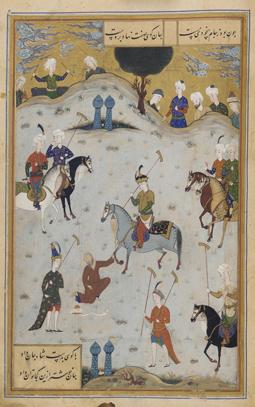Construction work on such a large scale must have left many documentary traces[1]. However, I am concerned with the symbolic depiction of Abbas’ maydan – and how its image was formed, and then transformed (in its second phase of construction). I therefore want to consider four of the Persian texts produced by Shah Abbas’ memorialisers.
Afushtah-yi Natanzi
Natanzi’s report of Abbas’ building at Isfahan was completed before the commercial phase of construction was started[2], so it gives a clear “picture of the original project and the reasons that lay behind it”[3]. Natanzi describes how for polo and horse-racing, in 1590/91, a “maydan was levelled, river sand was spread on it and it became a coloured reflector of the forms of the heavenly bodies”[4]. Then in 1595, in preparation for a mock-battle and a festival of lights in the maydan: “the upper and lower surfaces of the walls and buildings which surrounded the maydan were all smoothed”. The walls were painted with pictures of “wondrous creatures and marvellous creations”[5]. In each corner of the maydan a paradisial garden was laid out – as summed up in relevant verses quoted from the Quran[6].
[1] For example, there must have been a substantial number of legal transactions. As noted by Robert McChesney, many sources have yet to be collated, re-discovered, or analysed. Despite this, there are many more Persian texts available than can be analysed here. I do not read Persian well, so am restricted to reviewing translated texts.Robert McChesney, “Four Sources,” 103, 105-6.
[2] Written between 1589/90 and 1598. Robert McChesney, “Four Sources,” 104-5.
[3] Robert McChesney, “Four Sources,” 114.
[4] Robert McChesney, “Four Sources,” 106.
[5] Robert McChesney, “Four Sources,” 107.
[6] Robert McChesney, “Four Sources,” 107-8. The Quranic references are to descriptions of Paradise – though the reference given by McChesney to Quran 54: 32-33 is incorrect – this quote is actually in Quran 56: 32-33.
